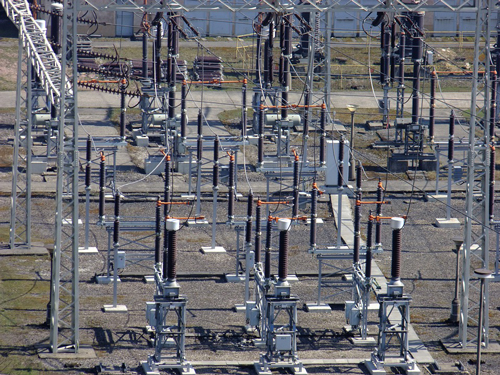
Substation is an important part of the power system. A lightning strike in a substation will cause a large-scale blackout and cause greater harm to the power grid. This requires that lightning protection measures must be very reliable.
The lightning strikes suffered by substations mainly come from two aspects: one is the direct lightning strike on the electrical equipment of the substation; the other is the lightning induced lightning overvoltage of overhead lines and the lightning wave formed by the direct lightning overvoltage invades the substation along the line. Therefore, it is very important to prevent direct lightning strikes and lightning intrusive waves from damage to substation incoming lines and transformers.
Direct lightning protection in substations Installing lightning rods is the main measure of direct lightning protection. Lightning rods are lightning receptors that protect electrical equipment and buildings from direct lightning strikes. It attracts thunder to itself and leads it safely into the ground, thereby protecting nearby equipment with lower insulation levels from lightning strikes.
When installing lightning rods, 35kV substations must be equipped with independent lightning rods, and meet the requirements of no counterattack; for 110kV and above substations, due to the high insulation level of such voltage level power distribution devices, lightning rods can be installed directly Based on the structure of the power distribution device, therefore, the high potential generated by the lightning rod will not cause a counterattack accident of electrical equipment.
Substation protection against intrusive waves of lightning The main measure of substation protection against intrusive waves is to install valve-type arresters or protective gaps on its incoming lines. The basic components of valve arresters are spark gap and nonlinear resistance.
Incoming line protection of substations The purpose of implementing lightning protection for the incoming lines of substations is to limit the amplitude of lightning current flowing through the arrester and the steepness of lightning waves. When an overvoltage occurs on the line, a traveling wave will travel along the wire to the substation, and its amplitude is 50% of the impulse flashover voltage of the line insulation. The impulse withstand voltage of the line is much higher than that of the substation equipment. Therefore, installing lightning protection wires on the incoming lines close to the substation is the main measure of lightning protection. If there is no lightning protection line, when the incoming line close to the substation is struck by lightning, the amplitude of the lightning current flowing through the arrester can exceed 5kA, and its steepness will exceed the allowable value, which is bound to cause damage to the line.
Transformer protection The basic protection measure of the transformer is to install a lightning arrester close to the transformer, so as to prevent the lightning wave from the line from damaging the insulation.
When installing the lightning arrester, try to be as close as possible to the transformer, and minimize the length of the connection to reduce the voltage drop of the lightning current on the connection line. At the same time, the wiring of the arrester should be connected with the metal shell of the transformer and the neutral point of the low-voltage side. In this way, when the intruding wave causes the arrester to operate, the voltage acting on the main insulation of the high-voltage side is only the residual voltage of the arrester ( Excluding the voltage drop on the grounding resistance), it reduces the chance of lightning damage to the transformer.
After the lightning protection of the substation meets the requirements, a unified grounding grid must be laid according to the requirements of safety and work grounding, and then a grounding body is added under the lightning rod and the lightning arrester to meet the requirements of lightning protection, or under the lightning protection device Lay a separate grounding body.
















 RCCN WeChat QrCode
RCCN WeChat QrCode Mobile WebSite
Mobile WebSite